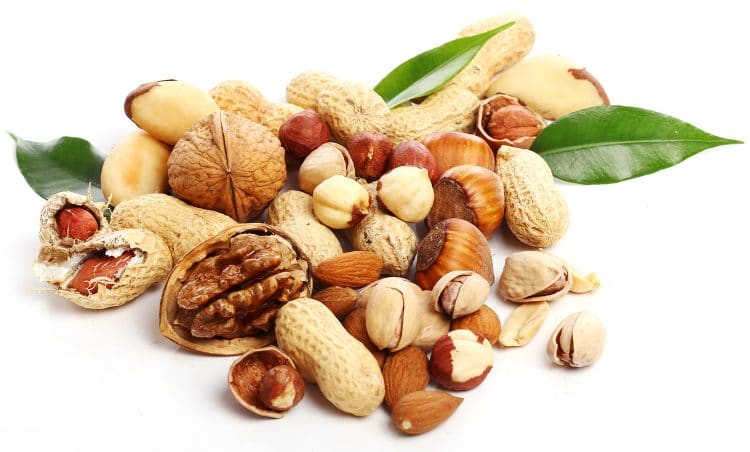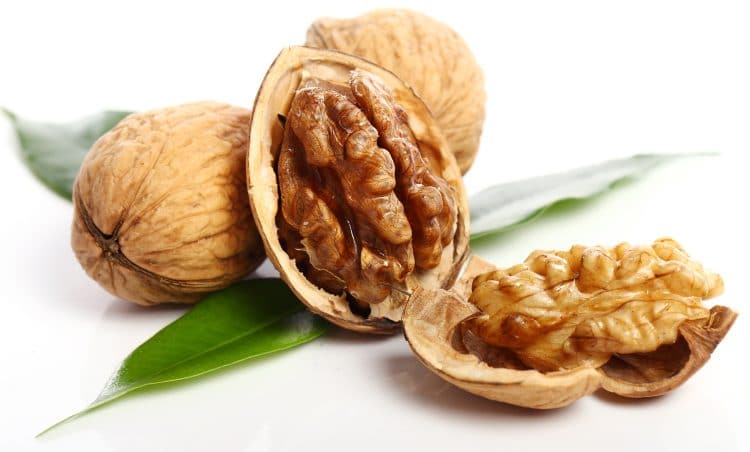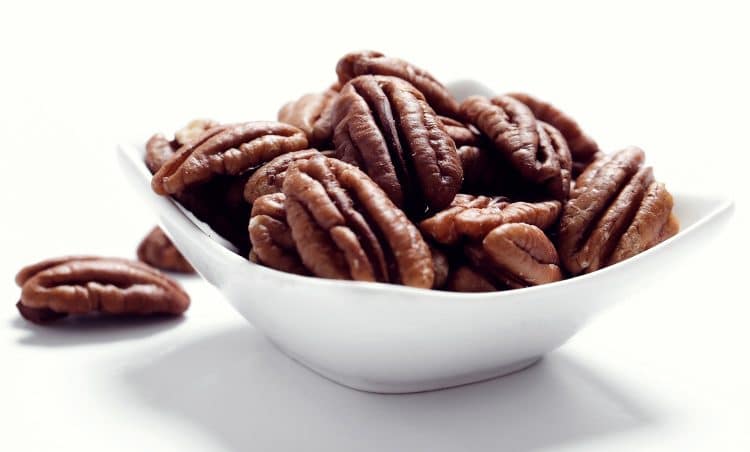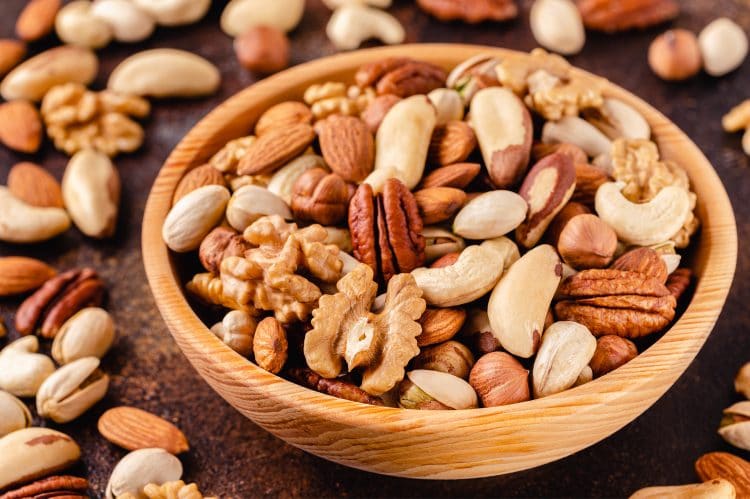Walnuts vs pecans — is one better than the other, or are they the same? If you can’t tell the difference between the two, don’t worry. You are not alone.
What Are Nuts?
Let’s start with the basics. Nuts are single-seeded dry fruits with high oil content. Usually, they have a protective husk and are enclosed in some type of solid and hard outer layer. [1]
Nuts are nutrient-dense foods with a complex matrix that is rich in healthy unsaturated fat and other bioactive compounds, including high-quality vegetable protein, fiber, minerals, tocopherols, phytosterols, and phenolic compounds. Several studies have associated nut consumption with a reduced incidence of coronary heart disease. Limited evidence also suggests beneficial effects on hypertension, cancer, and inflammation. [2]
At a glance, pecans and walnuts have a lot of similarities. They are roughly the same color, size, and texture, and often serve a similar role as a crunchy add-on in salads, desserts, and snacks. Despite their similarities, there are some significant differences when it comes to specific nutrient content between these two types of nuts.
Where do walnuts come from?
Level Up Your Fitness: Join our 💪 strong community in Fitness Volt Newsletter. Get daily inspiration, expert-backed workouts, nutrition tips, the latest in strength sports, and the support you need to reach your goals. Subscribe for free!
A walnut is the edible seed of a drupe of any tree of the genus Juglans (family Juglandaceae), particularly the Persian or English walnut, Juglans regia. They are the oldest tree food known to man, dating back to 7000 B.C. The word “walnut” derives from Old English “wealhhnutu,” meaning “foreign nut.” [3]
There are several types of walnut trees, but all of them produce edible brain-like shaped seeds, known as walnuts. There are two most common major species of walnut tree grown for their seeds — the Persian or English walnut and the black walnut.
The Persian or English walnut, Juglans regia, originated in Iran (Persia). In ancient Rome, people used to call them by their Latin name, which translates to “Jupiter’s royal acorn.” The second type, the black walnut or Juglans nigra, is native to eastern North America. This type of walnut has a strong flavor, but due to its hard shell and poor hulling characteristics, it is not commercially cultivated in orchards. [4][5]
Where do pecans come from?
Like walnuts, the pecan trees, or Carya illinoinensis, also belong to the Juglandaceae family but are from the Carya genus. It’s a species of hickory that is native to the southern United States and northern Mexico, in the region of the Mississippi River. [6] Although it is the only tree nut native to North America, it has worldwide popularity.
The origin of the name “pecan” dates back to the 16th century and is derived from the Algonquian word “pacane” (Native American), which roughly translates into “nuts that require a stone to crack.” Pecans were widely used by pre-colonial residents, because they were accessible to waterways, easier to shell than other North American nut species, and, of course, because of their great flavor. There are around five hundred different varieties of pecan, all of which are similar but vary a bit in shape, shell type, texture, oil content, and, most importantly, flavor. [7][8][9]
What do walnuts and pecans look like and taste?
Walnuts are larger and wider than pecans and have a more rounded, light brown shell that cracks open more easily. Pecans have a more oblong, dark brown shell and are a bit more difficult to crack open.
When it comes to edibility, walnuts are a bit lighter and larger, and have a shape that looks like a miniature human brain; maybe that’s why they are so good for the brain? On the other hand, pecans are typically found in their halved form. They are smaller than walnuts and have a brighter and warmer shade of brown, a more elliptical shape, and deep longitudinal ridges on the surface. Taste-wise, pecans are a bit sweeter and drier, while walnuts are slightly bitter and oily with an unmistakable nutty flavor. [10]
In terms of cost, walnuts tend to be less expensive and have a longer shelf-life compared to pecans. Walnuts and pecans can typically be swapped in most recipes, but there are a few key differences between the two when it comes to nutritional aspects, which you should be aware of before including them on your grocery list.
Nutritional Comparison
Nuts are a staple in the Mediterranean diet, and their consumption has been recommended to populations all over the world. Tree nuts are nutrient-dense foods that contain healthy fat, protein, fiber, vitamins E and K, folate, thiamine, minerals such as magnesium, copper, potassium, and selenium, and substances such as xanthophyll carotenoids, antioxidants, and phytosterols compounds. [11][12]
All these nutritional contents combined can improve human health — from the control of satiety and the increase of thermogenesis to acting in the prevention and/or treating of some risk factors related to chronic diseases, such as changes in glycemic and lipid metabolism, oxidative stress, and inflammation, among others.
Here is a full comparison with detailed information on the types of nutrients that are present in walnuts and pecans:
Macronutrients
Walnuts vs pecans – Protein content
Protein is an essential macronutrient and is found throughout the body, in muscle, bone, skin, hair, and virtually every other body part or tissue. [13]
According to the National Academy of Medicine, the Recommended Dietary Allowance (RDA) of protein for a healthy adult with minimal physical activity is 0.8 g per kg body weight per day; but to meet functional needs such as promoting skeletal-muscle protein accretion and physical strength, a dietary intake between 1.0 and 1.6 g protein per kg body weight per day is recommended for individuals with moderate to intense physical activity. [14]
Although all nuts are a good source of high-quality vegetable protein, walnuts have been found to have more protein than pecans: 4.31 g of protein and 2.9 g of protein, per ounce, respectively. [15][16]
Protein is made of more than twenty basic building blocks called amino acids, of which nine: histidine, isoleucine, leucine, lysine, methionine, phenylalanine, threonine, tryptophan, and valine; are known as the essential amino acids (EAA). The EAA must come from food since our body is unable to produce them naturally. Read also EAAs VS. BCAAs
Walnuts have a balanced content of all the essential amino acids, except for methionine, with respect to the pattern recommended by the United Nations Food and Agriculture Organization (FAO) for adults. On the other hand, pecans have a lower content of all the essential amino acids than walnuts. [17]
Related: Macronutrient Calculator
Walnuts vs pecans – Carbohydrate content
Like all nuts, walnuts and pecans are low in sugar and starch, but high in fiber, with a standard one-ounce serving providing 5–10% of daily fiber requirements.
Level Up Your Fitness: Join our 💪 strong community in Fitness Volt Newsletter. Get daily inspiration, expert-backed workouts, nutrition tips, the latest in strength sports, and the support you need to reach your goals. Subscribe for free!
Fiber is a type of carbohydrate that the body cannot digest. Unlike the rest of the carbohydrates that are broken down into sugar molecules, fiber cannot be broken down into sugar molecules, and instead, it passes through the body undigested. [18]
Research shows an inverse relationship between fiber consumption and the risk for coronary heart disease and several types of cancer. For that reason, the FDA published a health claim indicating that increased dietary fiber intake may reduce the prevalence of coronary heart diseases and cancer. [19]
So, what about the fiber content in walnuts and pecans?
If we analyze the fiber content in both types of nuts, the pecans come out on top with a slightly higher content of 2.72 g of fiber vs 1.9 g of fiber in walnuts, per ounce.
Walnuts vs pecans – Fat content
Most nuts have a high-fat content, but the good news is that the majority of these fats are the unsaturated healthy kind.
The mono and polyunsaturated fatty acids found in nuts, among other foods, are needed for brain development and blood clotting, but also improve blood cholesterol levels, reduce inflammation and stabilize heart rhythms. [20][21]
When comparing the two types of nuts, pecans have a slightly higher fat content than walnuts, 20.4 g of total fat vs 18.5 g of total fat, per ounce, respectively.
Digging deeper into the types of fats present, walnuts are richer in polyunsaturated fats, such as an Omega 6 fatty acid called linoleic acid and an Omega 3 fatty acid called alpha-linolenic acid or ALA.
In fact, walnuts are the only type of nut that contains a significant amount of ALA. This type of polyunsaturated fatty acid is an essential nutrient because our body cannot produce it on its own, and it’s beneficial for heart health, helps reduce inflammation, improves the composition of blood fats, and is a precursor for other essential Omega-3 fatty acids, EPA and DHA, which are involved in proper fetal development. [22][23]
In contrast, pecans are richer in monounsaturated fats Omega-9 fatty acid, called oleic acid that can help lower your “bad” LDL cholesterol levels, but have very little content of ALA.
Micronutrients
Micronutrients, such as vitamins and minerals, are vital to healthy development, disease prevention, and well-being, and all of them, except for vitamin D, are not produced in the body and must come from the foods we eat. Even though you only need a small amount of vitamins and minerals to meet your daily needs, micronutrient deficiencies are common phenomena that can have devastating consequences on an individual’s health if left unchecked. [25]
Furthermore, both pecans and walnuts are great sources of micronutrients such as vitamins, minerals, and antioxidants.
Walnuts vs pecans – Vitamin content
Pecans are packed with vitamins, including vitamin E — a fat-soluble vitamin that works as an antioxidant and helps prevent cell damage; vitamin B1 or thiamine, a vitamin essential for converting carbohydrates into energy to help fuel your body; and vitamin A, another fat-soluble vitamin essential for vision and cellular differentiation. [27][28]
Walnuts also have a high vitamin E content but are richer in vitamin B9, or folate, a vitamin that plays an essential role in DNA biosynthesis; and vitamin B6, which helps strengthen your immune system and support nerve health. [29][30]
Walnuts vs pecans – Mineral content
When it comes to minerals, both pecans and walnuts are rich in copper, a mineral that promotes heart health and helps maintain bone, nerve, and immune system function. [31]
Pecans have a higher manganese content, a trace element that is a cofactor for many enzymes involved in metabolism, and zinc, necessary for immune function, cell growth, brain function, and wound healing. [32][33]
Walnuts are richer in calcium, an essential component of bones and teeth, but also important for contraction and dilation of blood vessels, muscle function, blood clotting, nerve transmission, and hormonal secretion; and selenium, another type of trace elements that is part of more than two dozen selenoproteins, that have a crucial role in reproduction, thyroid hormone metabolism, DNA synthesis, among others. [34][35]
Walnuts vs pecans – Nutritional values comparison
Nutritional content of walnuts and pecans per ounce:
| Walnuts (approx. 14 halves) | Pecans (approx. 19 halves) | |
| Calories | 185 | 196 |
| Protein (g) | 4.31 | 2.6 |
| Carbohydrate (g) | 3.88 | 3.94 |
| Fiber (g) | 1.9 | 2.72 |
| Total fat (g) | 18.5 | 20.4 |
| Saturated fat | 1.74 | 1.75 |
| Monounsaturated fat | 2.53 | 11.6 |
| Polyunsaturated fat | 13.4 | 6.12 |
| Linoleic acid (omega-6) | 10.8 | 5.84 |
| Linolenic acid- ALA (omega-3) | 2.57 | 0.28 |
| Vitamin A (mcg) | 0.285 | 0.851 |
| Vitamin E (as gamma-tocopherol) (mg) | 5.9 | 6.92 |
| Thiamine (B1) (mg) | 0.097 | 0.187 |
| Folate (B9) (mcg) | 27.8 | 6.24 |
| Vitamin B6 (mg) | 0.152 | 0.06 |
| Copper (mg) | 0.451 | 0.34 |
| Magnesium (mg) | 44.8 | 34.3 |
| Potassium (mg) | 125 | 116 |
| Phosphorous (mg) | 98.1 | 78.5 |
| Manganese (mg) | 0.967 | 1.28 |
| Zinc (mg) | 0.876 | 1.28 |
| Calcium (mg) | 27.8 | 19.8 |
| Selenium (mcg) | 1.39 | 1.08 |
What About Nut Allergies?
Tree nut allergies are one of the eight most common food allergies, affecting roughly 0.5 to 1% of the U.S. population. If you are allergic to one type of tree nut, it does not necessarily mean you are allergic to other tree nuts as well. However, certain tree nuts are closely related, including pecans and walnuts. In the U.S., the most common nut allergy is cashew, followed by walnut. [36][37]
FAQs
Which is better, walnuts or pecans?
The answer to this question will depend on the health outcome that you are looking for.
For instance, if your goal is heart care, you should choose walnuts since they have a higher ALA content; but if you’re looking to increase your fiber intake, it’s best to stick with pecans.
Can I substitute one nut for the other?
In most recipes, you can substitute pecans for walnuts, and vice versa, in equal measure, but keep in mind that pecans have a more delicate taste and are a bit sweeter, while walnuts are a bit oilier and bitter.
Why are walnuts cheaper than pecans?
Pecan trees can take up to 10 years to mature and produce a real crop, whereas a walnut tree can take between five to seven years for it to become an adult and produce a real crop.
Should I stop eating nuts to lose weight?
Eating nuts regularly is deemed healthy and is associated with weight loss. However, it’s important to keep in mind that they are high-fat foods, and we need to exercise portion control.
Public health guidelines recommend eating a one-ounce portion of nuts on most days of the week.
Wrapping Up – Which is better, walnuts or pecans?
It is not easy to decide between pecans and walnuts. Both are easily accessible, nutrient-dense, and, above all, have great health benefits.
However, on analyzing their nutritional contributions in detail, we find that walnuts have a higher protein content, which can be useful in cases where a higher protein intake is necessary, such as athletes, pregnant women, and the elderly. In addition, nuts have a very good balance of all the essential amino acids that our body needs, making them even more tempting.
Pecans, on the other hand, have a higher fiber content than walnuts. This is beneficial because fiber can help keep us satiated and feeling full for longer. According to FDA health claims, a high fiber intake may reduce the prevalence of coronary heart disease and cancer.
In terms of fat content, both are equally good. However, it is noteworthy that walnuts are one of the few plant foods with a high content of linolenic acid, or Alpha-Linolenic Acid (Ala). This fatty acid is essential for our health as it helps reduce “bad” LDL cholesterol levels and increases “good” HDL cholesterol levels. It also aids us in inflammatory processes and is a precursor of EPA and DHA fatty acids, which are necessary for proper fetal development.
When it comes to micronutrients, pecans are richer in vitamin A, thiamine, manganese, and zinc, while walnuts provide more folate, vitamin B6, calcium, and selenium. All micronutrients are essential for good health and consuming both pecans and walnuts is highly beneficial for our overall health.
It is important to highlight that, despite all the nutritional benefits that the consumption of nuts has on our health, we must not forget that they have a very high-fat content. An individual must keep their fat consumption under check, especially if they are on a fat loss program as consuming too many high-fat foods can be counterproductive to your goal.
References
- Nuts-Definition and types. Forest Service U.S. DEPARTMENT OF AGRICULTURE. [2022, April 6]. https://www.fs.fed.us/wildflowers/ethnobotany/food/nuts.shtml
- Ros E. Health Benefits of Nut Consumption. Nutrients. 2010 Jun 24;2(7):652–82. https://doi.org/10.3390/nu2070652
- Walnut – New World Encyclopedia. [2022, April 7]. https://www.newworldencyclopedia.org/entry/Walnut
- Walnuts trees. Wikipedia. [2022, April 6]. https://en.wikipedia.org/w/index.php?title=Walnut&oldid=1080831527
- History of walnuts. California Walnuts. [2022, April 6]. https://walnuts.org/about-walnuts/history/
- Pecans trees. Wikipedia. [2022, April 6]. https://en.wikipedia.org/w/index.php?title=Pecan&oldid=1071862566
- History of Pecans. U.S. Pecans. [2022, April 6]. https://uspecans.org/history-of-pecans/
- Pecans-A Timeline & Fun Facts. [2022, April 6]. https://ilovepecans.org/a-timeline-fun-facts/
- Different Types Of Pecans. Millican Pecan. [2022, April 7]. https://millicanpecan.com/blogs/pecan-orchards/are-there-different-types-of-pecans-faq
- What is the Difference Between Pecans and Walnuts? Millican Pecan. [2022, April 7]. https://millicanpecan.com/blogs/nutrition/what-is-the-difference-between-pecans-and-walnuts
- Ventriglio A, Sancassiani F, Contu MP, Latorre M, Di Slavatore M, Fornaro M, et al. Mediterranean Diet and its Benefits on Health and Mental Health: A Literature Review. Clin Pract Epidemiol Ment Health CP EMH. 2020 Jul 30;16(Suppl-1):156–64. https://doi.org/10.2174/1745017902016010156
- De Souza RGM, Schincaglia RM, Pimentel GD, Mota JF. Nuts and Human Health Outcomes: A Systematic Review. Nutrients. 2017 Dec;9(12):1311. https://doi.org/10.3390/nu9121311
- Protein. The Nutrition Source. Harvard: School of Public Health. [2022, April 8]. https://www.hsph.harvard.edu/nutritionsource/what-should-you-eat/protein/
- Wu G. Dietary protein intake and human health. Food Funct. 2016 Mar 16;7(3):1251–65. https://doi.org/10.1039/C5FO01530H
- U.S. DEPARTMENT OF AGRICULTURE. FoodData Central-Walnuts. [2022, April 8]. https://fdc.nal.usda.gov/fdc-app.html#/food-details/170187/nutrients
- U.S. DEPARTMENT OF AGRICULTURE. FoodData Central-Pecans. [2022, April 8]. https://fdc.nal.usda.gov/fdc-app.html#/food-details/170182/nutrients
- Mao X, Hua Y, Chen G. Amino Acid Composition, Molecular Weight Distribution and Gel Electrophoresis of Walnut (Juglans regia L.) Proteins and Protein Fractionations. Int J Mol Sci. 2014 Jan 27;15(2):2003–14. https://doi.org/10.1039/C5FO01530H
- Carbohydrate. The Nutrition Source. Harvard: School of Public Health. [2022, April 8]. https://www.hsph.harvard.edu/nutritionsource/carbohydrates/fiber/
- Lattimer JM, Haub MD. Effects of Dietary Fiber and Its Components on Metabolic Health. Nutrients. 2010 Dec 15;2(12):1266–89. https://doi.org/10.3390/nu2121266
- Types of Fat. The Nutrition Source. Harvard: School of Public Health. [2022, April 8]. https://www.hsph.harvard.edu/nutritionsource/what-should-you-eat/fats-and-cholesterol/types-of-fat/
- What Types of Fat Are in Foods? WebMD. [2022, April 8]. https://www.webmd.com/diet/guide/types-fat-in-foods
- Swanson D, Block R, Mousa SA. Omega-3 Fatty Acids EPA and DHA: Health Benefits Throughout Life. Adv Nutr. 2012 Jan 1;3(1):1–7. https://doi.org/10.3945/an.111.000893
- Zhao G, Etherton TD, Martin KR, West SG, Gillies PJ, Kris-Etherton PM. Dietary α-Linolenic Acid Reduces Inflammatory and Lipid Cardiovascular Risk Factors in Hypercholesterolemic Men and Women. J Nutr. 2004 Nov 1;134(11):2991–7. https://doi.org/10.1093/jn/134.11.2991
- Facts about monounsaturated fats: MedlinePlus Medical Encyclopedia. [2022, April 9]. https://medlineplus.gov/ency/patientinstructions/000785.htm
- CDC. Micronutrient Facts. Centers for Disease Control and Prevention. [2022, April 9]. https://www.cdc.gov/nutrition/micronutrient-malnutrition/micronutrients/index.html
- Pecans: Antioxidant-Packed Nuts. WebMD. [2022, April 9]. https://www.webmd.com/food-recipes/features/pecans-antioxidant-packed-nuts
- Vitamin B1 (Thiamine). Martel JL, Kerndt CC, Doshi H, Franklin DS. StatPearls Publishing; 2022 [2022, April 9]. http://www.ncbi.nlm.nih.gov/books/NBK482360/
- Vitamin A. Chea EP, Lopez MJ, Milstein H. StatPearls Publishing; 2022 [cited 2022, April 9]. http://www.ncbi.nlm.nih.gov/books/NBK482362/
- Folic Acid. Merrell BJ, McMurry JP. StatPearls Publishing; 2022 [2022, April 9]. http://www.ncbi.nlm.nih.gov/books/NBK554487/
- Vitamin B6: MedlinePlus Medical Encyclopedia. [2022, April 9]. https://medlineplus.gov/ency/article/002402.htm
- Copper in diet: MedlinePlus Medical Encyclopedia. [2022, April 9]. https://medlineplus.gov/ency/article/002419.htm
- Manganese. Office of Dietary Supplements (ODS) at the National Institutes of Health [2022, April 9]. https://ods.od.nih.gov/factsheets/Manganese-HealthProfessional/
- Zinc. Office of Dietary Supplements (ODS) at the National Institutes of Health [2022, April 9]. https://ods.od.nih.gov/factsheets/Zinc-HealthProfessional/
- Calcium. Office of Dietary Supplements (ODS) at the National Institutes of Health [2022, April 10]. https://ods.od.nih.gov/factsheets/Calcium-HealthProfessional/
- Selenium. Office of Dietary Supplements (ODS) at the National Institutes of Health [2022, April 9]. https://ods.od.nih.gov/factsheets/Selenium-HealthProfessional/
- Everything You Need to Know about Tree Nut Allergy. [2022, April 10]. https://www.aaaai.org/tools-for-the-public/conditions-library/allergies/everything-you-need-to-know-about-tree-nut-allergy
- What Is the Most Common Tree Nut Allergy? MedicineNet. [2022, April 10]. https://www.medicinenet.com/what_is_the_most_common_tree_nut_allergy/article.htm













